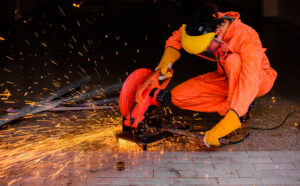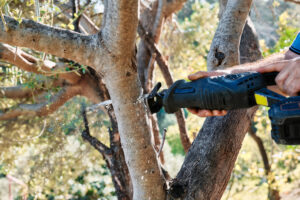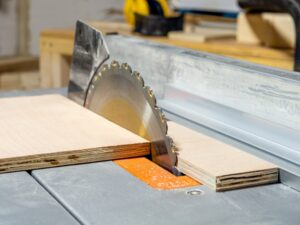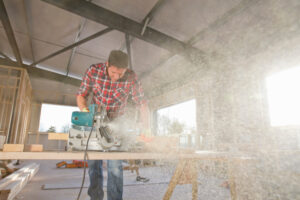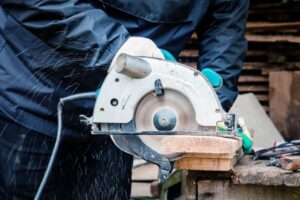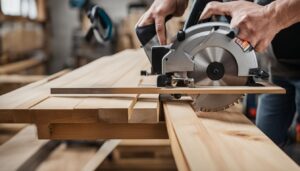Your circular saw is a powerful tool that can be used for both professional and DIY projects. However, it’s important to know how to use it safely to avoid accidents.
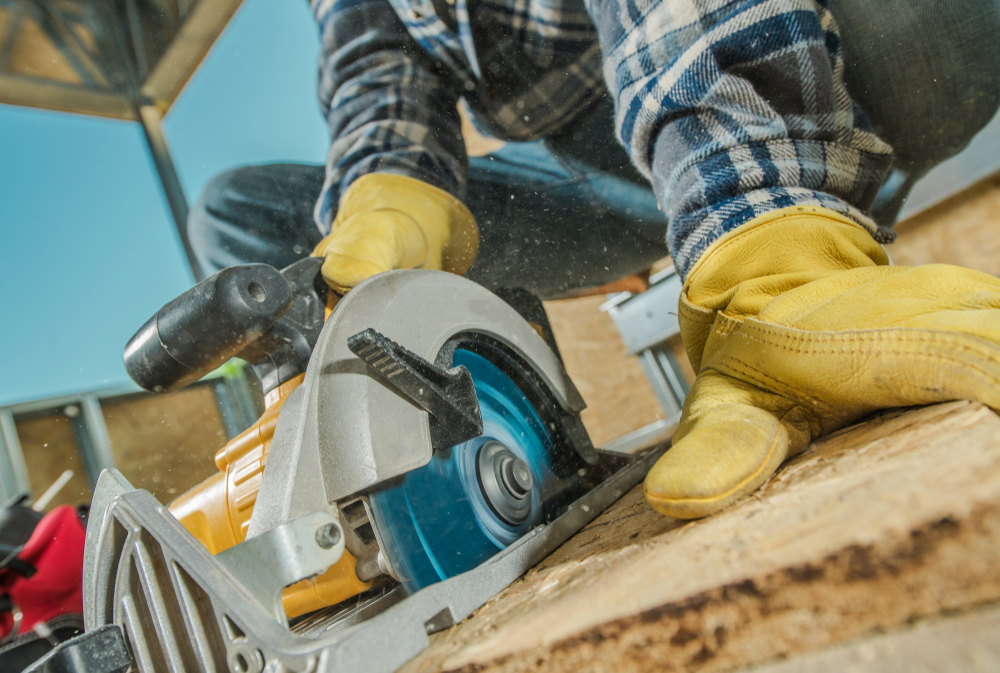
Key Takeaways
- Proper usage of a circular saw is crucial for safety.
- Always follow safety precautions and wear appropriate protective equipment.
- Familiarise yourself with the parts and functions of your circular saw.
- Select the right blade for clean and accurate cuts.
- Ensure you have the necessary equipment and tools for using a circular saw.
Staying Safe When Working with a Circular Saw
When it comes to working with a circular saw, safety should always be your top priority. By following a few important precautions, you can minimise the risk of accidents and ensure a safe working environment. Here are some key safety measures to keep in mind:
- Keep all cables and leads securely away from the cutting path. This will help prevent accidental tripping or entanglement with the saw.
- Never take your eyes off the cutting area while the saw is in operation. It only takes a split second for an accident to occur, so maintain focus and concentration at all times.
- Avoid cutting between two points of pressure, as this can cause the blade to bind and lead to kickback. Always use proper cutting techniques and make sure the blade is clear before proceeding.
- Ensure that your workpiece is firmly supported throughout the cutting process. Use clamps or a workbench to keep the material stable and secure.
- Wear safety glasses and a dust mask to protect your eyes and respiratory system from flying debris. These simple precautions can make a significant difference in reducing the risk of injury.
Safety Precautions
When using a circular saw, it’s important to take certain safety precautions to prevent accidents. Here are some additional tips to consider:
- Always read and follow the manufacturer’s instructions and safety guidelines provided with your circular saw.
- Before starting any cutting operation, inspect the saw and ensure that all guards and safety features are in place and functioning properly.
- Do not wear loose clothing, jewellery, or gloves while operating the saw, as they can become entangled in the blade.
- Avoid overreaching or standing in an unstable position while using the saw. Maintain a stable stance and position your body to maintain good balance.
Circular Saw Kickback
Circular saw kickback is a sudden and violent reaction that can occur when the blade binds, stalls, or encounters other obstacles during cutting. To prevent kickback, follow these guidelines:
- Use a sharp blade and avoid forcing it through the material. Let the blade do the work.
- Be cautious when cutting through knots or other irregularities in the material, as they can cause the blade to bind.
- When making long rip cuts, use a guide or fence to ensure a straight and controlled cut.
Get to Know Your Circular Saw
Before using a circular saw, it’s important to familiarise yourself with its various parts and functions. Understanding the different components of the tool will enable you to operate it effectively and safely. Below is a diagram that outlines the essential parts of a circular saw:
| Part | Function |
|---|---|
| Depth Adjustment | Allows you to adjust the cutting depth of the blade. |
| Base-Plate | Provides stability and support for the saw during cutting. |
| Trigger | Controls the power and speed of the saw. |
| Retracting Blade Guard | Protects the user from the exposed blade when not in use. |
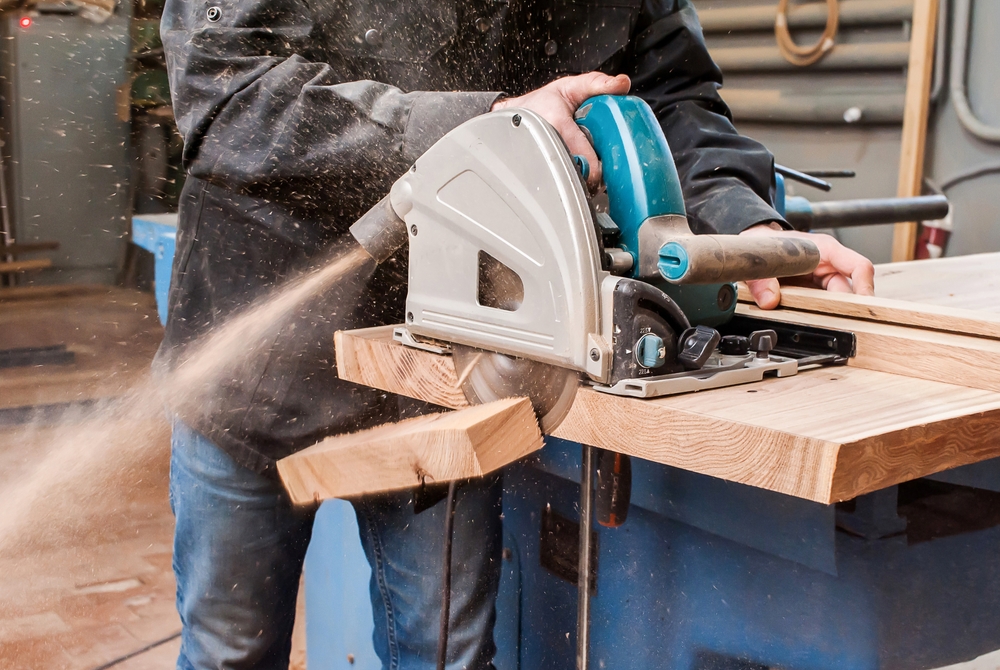
Choosing the Right Circular Saw Blade
When it comes to achieving precise and clean cuts with your circular saw, choosing the right blade is crucial. The blade you use will depend on the type of material you’re cutting and the type of cut you want to make. Here are some important factors to consider when selecting a circular saw blade:
Diameter
The diameter of the blade refers to the size of the blade itself. Circular saw blades come in various diameters, typically ranging from 4 inches to 12 inches. The size you choose will depend on the depth of cut you need to achieve. Smaller blades are suitable for cutting thin materials, while larger blades are better for thicker materials. Keep in mind that the size of the blade must be compatible with your circular saw.
Arbour Hole Size
The arbour hole size refers to the diameter of the hole in the centre of the blade where it attaches to the circular saw’s arbour. It’s crucial to select a blade with an arbour hole size that matches the size of your saw’s arbour. Using a blade with the wrong arbour hole size can lead to improper alignment, causing vibrations, and potentially dangerous situations.
Blade Type
Circular saw blades come in various types, each designed for different purposes. Here are some common blade types:
- Cross-cut blades: Ideal for making smooth and precise cuts across the grain of the wood.
- Rip-cut blades: Designed for cutting along the grain of the wood in a straight line.
- Combination blades: These blades are versatile and can handle both cross-cutting and rip-cutting tasks.
- Framing blades: Specifically designed for cutting through rough construction materials like lumber and plywood.
By considering factors like blade diameter, arbour hole size, and blade type, you can select the most suitable circular saw blade for your specific cutting needs. Remember to always follow the manufacturer’s recommendations and consult your saw’s manual for further guidance on blade selection.
Essential Equipment for Using a Circular Saw
When it comes to using a circular saw, having the right equipment is crucial for a safe and efficient woodworking experience. Whether you’re a professional carpenter or a DIY enthusiast, the following tools and accessories should be in your arsenal:
Work Table
A sturdy work table or bench is essential for supporting your material during cutting. It provides stability and prevents the workpiece from moving while you make precise cuts. Make sure the table is flat, level, and large enough to accommodate the size of your material. This will help you maintain control over the circular saw and reduce the risk of accidents.
Extension Cord
Using a reliable and properly rated extension cord is necessary to power your circular saw. Ensure that the cord is long enough to allow you to move freely, but not too long to create a tripping hazard. Look for an extension cord with a high amp rating to handle the power demands of your saw. Additionally, check for any damages or frayed wires before use to avoid electrical hazards.
Safety Equipment
Protective gear is essential when operating a circular saw, as it helps minimise the risk of injuries. Safety glasses should be worn to shield your eyes from flying debris, while a dust mask will protect your lungs from sawdust particles. Depending on the noise level, consider using ear defenders to prevent hearing damage. Lastly, don’t forget to wear appropriate clothing, such as long sleeves and closed-toe shoes, to protect your skin and feet.
Marking Tools
Precise measurements and markings are crucial for accurate cuts. Keep a pencil, tape measure, and tri-square handy to mark your workpiece before making any cuts. The pencil markings will guide your blade, ensuring that you achieve the desired dimensions and angles.
| Equipment | Description |
|---|---|
| Work Table | A sturdy and flat surface for supporting materials during cutting. |
| Extension Cord | A properly rated cord that provides power to the circular saw. |
| Safety Equipment | Protective gear including safety glasses, dust mask, and ear defenders. |
| Marking Tools | Pencil, tape measure, and tri-square for accurate measurements and markings. |
How to Safely Make a Cut With Your Circular Saw
When it comes to using a circular saw, knowing how to make a clean and safe cut is essential. Whether you’re working on a cross-cut or a rip-cut, following proper techniques will help you achieve accurate results. Here are some tips to help you safely make a cut with your circular saw:
Setting the Blade Depth
Before you start cutting, it’s important to set the blade depth correctly. The blade should extend approximately 5-10mm below the material you’re cutting. This will ensure efficient cutting while minimising the risk of kickback. Use the depth adjustment feature on your circular saw to achieve the desired depth.
Supporting Your Workpiece
Properly supporting your workpiece is crucial to maintaining control and achieving a clean cut. Make sure your material is securely positioned on a stable work surface or workbench. If needed, use clamps or other supports to prevent the material from moving during the cut. This will ensure straight and accurate cuts.
Marking Before Cutting
Marking your lumber before cutting is a simple yet effective way to ensure precision. Use a pencil or a marking tool to indicate the line or shape you want to cut. This will serve as a guide for keeping your cut accurate and consistent. Take your time to make clear and visible markings before starting the cut.
Techniques for Cross-Cuts and Rip-Cuts
When it comes to making different types of cuts with a circular saw, two main techniques are commonly used: cross-cutting and rip-cutting. Cross-cutting refers to cutting across the grain of the wood, while rip-cutting involves cutting along the length of the grain.
To make a cross-cut, position the circular saw at the starting point of your marked line and align the blade with the line. Hold the saw firmly, engage the trigger, and let the blade smoothly move across the material. Maintain a steady pace and follow the marked line to ensure a straight and accurate cut.
Rip-cutting involves cutting with the grain of the wood. To make a rip-cut, position the circular saw next to the marked line, ensuring that the blade is slightly on the waste side of the material. Hold the saw firmly, engage the trigger, and guide the saw along the marked line, moving in a straight and controlled manner. Take your time and avoid forcing the saw to maintain control and achieve a clean cut.
Conclusion
As I wrap up this guide on using a circular saw safely, I want to emphasize the importance of prioritising your safety whenever you embark on a carpentry project. By following the tips and techniques shared throughout this article, you can confidently use your circular saw and achieve precise cuts while minimising the risk of accidents.
Always remember to refer to your saw’s manual for specific instructions and safety guidelines. It’s crucial to wear the appropriate protective equipment, including safety glasses and a dust mask, to shield yourself from flying debris. Additionally, choose the right blade for your project, ensuring it aligns with your saw’s specifications for diameter and arbour hole size.
When making cuts, be sure to set the blade depth correctly and support your workpiece securely. Start with simple cross-cuts if you’re new to using a circular saw, gradually progressing to more complex rip-cuts. And above all, avoid forcing the saw during cutting, as this can lead to kickback and potential injuries.
By following these circular saw safety tips and using your saw with caution, you can unleash its full potential while keeping yourself and others safe. So go ahead, tackle those woodworking projects with confidence and precision!
FAQ
What safety precautions should I follow when using a circular saw?
Keep all cables and leads away from the cutting path, never take your eyes off the cutting area, avoid cutting between two points of pressure to prevent kickback, ensure proper support for your workpiece, and wear safety glasses and a dust mask.
How can I familiarise myself with the parts of a circular saw?
Refer to the diagram provided in this guide, which outlines the different parts of a circular saw, including the depth adjustment, base-plate, trigger, and retracting blade guard.
How do I choose the right blade for my circular saw?
Consider the blade diameter and arbour hole size that your saw can handle, as well as choosing a blade with a higher RPM rating than your saw’s maximum speed. Different blade types have specific uses and provide different finishes.
What equipment do I need when using a circular saw?
You’ll need a sturdy work table or bench, an extension cord, safety equipment such as safety glasses and a dust mask, and basic marking and measuring tools such as a pencil, tape measure, and tri-square.
What types of cuts can I make with a circular saw?
You can make cross-cut and rip-cut with a circular saw. Set the blade depth properly, support your workpiece securely, and follow proper techniques to make safe cuts.
How can I use a circular saw safely?
Always follow the safety guidelines provided in this guide and your saw’s manual, wear appropriate protective equipment, choose the right blade, and use the saw with caution.
- Drill Battery Maintenance: Essential Tips for Cordless Drill Battery Care - February 5, 2024
- Troubleshooting Drill Issues - February 5, 2024
- Quick Drilling Techniques - February 2, 2024


